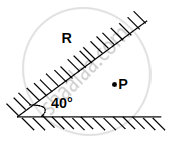Advertisements
Advertisements
प्रश्न
Use the mirror equation to show that an object placed between f and 2f of a concave mirror forms an image beyond 2f.
उत्तर
\[\text { For a concave mirror, the focal length (f) is negative } . \]
\[ \therefore f < 0\]
\[\text { When the object is placed on the left side of the mirror, the object distance (u) is negative } . \]
\[ \therefore u < 0\]
\[\text { For image distance v, we can write the mirror formula as }: \]
\[\frac{1}{f} = \frac{1}{v} + \frac{1}{u}\]
\[\frac{1}{v} = \frac{1}{f} - \frac{1}{u} . . . . . (i) \]
\[\text { The object lies between f and 2f }\]
\[ \Rightarrow 2f < u < f ( \because \text { u and f are negative })\]
\[ \frac{1}{2f} > \frac{1}{u} > \frac{1}{f}\]
\[ - \frac{1}{2f} < - \frac{1}{u} < - \frac{1}{f}\]
\[\frac{1}{f} - \frac{1}{2f} < \frac{1}{f} - \frac{1}{u} < 0\]
\[\text { Using equation (i), we get }: \]
\[\frac{1}{2f} < \frac{1}{v} < 0\]
\[ \therefore \frac{1}{v}\text { is negative, i . e . , v is negative }\]
\[\frac{1}{2f} < \frac{1}{v}\]
\[ 2f > v\]
Therefore, the image lies beyond 2f.
\[ - v > - 2f\]
APPEARS IN
संबंधित प्रश्न
Use the mirror equation to show that an object placed between f and 2f of a concave mirror produces a real image beyond 2f.
A point source of light is placed in front of a plane mirror.
Mark the correct options.
A light ray falling at an angle of 45° with the surface of a clean slab of ice of thickness 1.00 m is refracted into it at an angle of 30°. Calculate the time taken by the light rays to cross the slab. Speed of light in vacuum = 3 × 108 m s−1.
A light ray is incident normally on the face AB of a right-angled prism ABC (μ = 1.50) as shown in figure. What is the largest angle ϕ for which the light ray is totally reflected at the surface AC?

Name the physical principle on which the working of optical fibers is based.
A parallel beam of light is allowed to fall on a transparent spherical globe of diameter 30cm and refractive index 1.5. The distance from the centre of the globe at which the beam of light can converge is ______ mm.
An upright object is placed at a distance of 40 cm in front of a convergent lens of a focal length of 20 cm. A convergent mirror of focal length 10 cm is placed at a distance of 60 cm on the other side of the lens. The position and size of the final image will be ______.
Two plane mirrors are inclined at an angle of 40°. The possible number of images of an object placed at point P would be?

A point object is placed at a distance of 30 cm from a convex mirror of a focal length of 30 cm. What is the separation between the image and the object?
